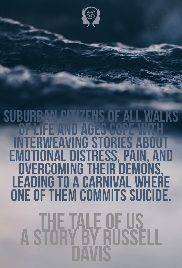THE TALE OF US, though it contains the seeds of a compelling narrative with its intense emotions and often violent actions, is hampered by the lack of a dramatic through-line, by under-developed characters, by unclear character arcs, and by the absence of a resonant theme tying its disparate threads together. Without addressing these underlying issues, the script’s strengths will remain unrealized.
It opens with a brief, dramatic moment—a shadowed man collapses on the ground as a car races to hit him. The next scene begins with A FEW DAYS EARLIER, and focuses on the character Ace Anderson. However, it’s not clear whether or not we’re meant to recognize Ace is the man in the first scene. At the end, we learn that it is Ace. But we need to know now whether or not he’s recognizable. If he is, we’re waiting to see how he comes to this bad end. If he’s not, then the end will play as a surprise.
Ace showers with his wife, when the image of a 12-year-old girl, Mika, appears on his wife’s face. This introduces a troubling thread, that of Ace, a school teacher, being sexually attracted to his young student. A thread which eventually leads to Ace and the child engaged in a sexual act. This is, to say the least, a delicate subject for any movie to broach, and unfortunately, as presented here, its inclusion does not feel justified. More on that below.
Following Ace’s introduction are a series of scenes introducing the other characters in this ensemble piece. While these scenes are intended only to be introductory, they lack cohesion. There’s no sense that these characters belong in the same movie. Some are introduced only fleetingly, while in the case of Deacon a lengthy flashback to a drunken night is shown. It’s unclear why this is necessary, as nothing that happens in the flashback becomes relevant later in the script. Knowing he’s an alcoholic is enough.
Soon we come to the next troubling sequence, where 17-year-old Gina meets Henry in a café, takes him home once he pegs her as a prostitute, and is then brutally beaten and raped by him. Again, a scene like this may work in certain movies, but it feels gratuitous here. What’s missing is any kind of point of view for these characters and scenes. A much stronger theme would have to be developed for this kind of violence to feel justified. Here the scenes seem to be presented merely as “terrible things happening.” That they only happen to girls feels troublesome at best.
Monica, the mother of Mika, the 12-year-old, comes to see Ace at Mika’s school. Two scenes follow where Ace and Monica aggressively flirt with each other. It’s over the top. Two people can flirt with nothing but their eyes or the intonation of their voices. Here we have Monica stroking Ace’s face and telling him his eyes are “fucking hot.” There is nothing subtle or affecting here. It’s two people bluntly saying they want to have sex. These scenes would play much better if their conversation was about everything except what they felt for each other.
This brings up an issue throughout the script: On-the-nose dialogue. Nothing is implied by these characters. Everything they think, feel, and desire is stated bluntly. It is worth considering that, by and large, although what people say is informed by what they want (and think and feel), it is rare that it’s expressed directly, or without at least some amount of cover. The inclusion of subtext throughout the script is recommended.
By page 30, another problem becomes clear: The static unfolding of scenes. Even in an ensemble piece, there needs to be a sense of dramatics, of sequences, of the rise and fall of action. In most scripts we would expect by about page 30 to have identified the protagonist’s primary goal and begun to understand the difficulties in achieving it. An ensemble piece is no different. We need to understand what these characters want, and what’s preventing them from getting it.
The scenes here unfold one after the other, with no attention to pacing, often without new information being supplied. So a scene with Deacon and Iowa at a bar tells us nothing but what we already know, that Deacon is an alcoholic. Whatever story is being told about him, nothing here advances it. Many scenes play without moving the story forward.
Gina, after having been raped and beaten, tries to drown herself. She is rescued by Mia. Later, the hospital releases Gina, not yet an adult, into the care of Mia. This seems improbable, both legally and in terms of Mia’s motivation. Later it’s revealed that Mia is, possibly, a lesbian, though this is presented as something to hide and be ashamed of. In this day and age, playing lesbianism in this manner makes the story feel retrogressive. This is further exacerbated by the implication that Mia only took Gina to her house in order to have sex with her. That this is left unclear makes understanding these two characters or relating to them difficult. The motivations of both remain obscure. What do they wish to achieve? What are they overcoming? Or failing to overcome?
The storyline involving the teen girl Sarah and her boyfriend Bobby is likewise underdeveloped. Bobby is dying of leukemia and wants to have sex. Sarah wants to wait until she’s married, until she learns about the leukemia. They get tested for STDs and it turns out Sarah has Hep B. She doesn’t tell Bobby and has sex with him anyway. What isn’t at all clear is why she doesn’t tell him. What about her character would lead her to do this? She’s principled until she isn’t.
There is talk of a carnival throughout the script, and toward the end a number of characters attend it. The location is a great choice for all of the disparate threads of an ensemble piece to join up, but as played here, little transpires, and the promise of the carnival goes unfulfilled. In terms of action, the one dramatic moment is Henry shooting himself. Unfortunately, we have nothing invested in this character. His only major action in the story is to beat and rape Gina. His suicide has no discernable effect on any other characters, either emotionally or story-wise.
The carnival should be the key sequence. It is, essentially, promised as much throughout the script. It must be realized for the script to work, and to do so, the characters must be given clear emotional and story arcs that find some kind of resolution at the carnival, or else through whatever happens at the carnival.
For example, if Henry is going to shoot himself, have it mean something to one of the other characters, even one who doesn’t know Henry. Maybe just seeing something so horrible will change a character’s trajectory; maybe they were considering suicide but now see its horror and pointlessness.
Furthermore, a carnival is packed with juicy cinematic possibilities, from rides to games to scary clowns to darkened boardwalks. These should be utilized.
Another suggestion along these lines would be to locate the story in a specific city. As it stands, we don’t know where this is set. Ensemble pieces are typically served well by the cities in which they take place, with the cities themselves effectively becoming characters.
What is largely missing from THE TALE OF US is a sense of why these characters and their stories fit together. What is being said here? One thread is violence toward women, but only in the sense that there’s a lot of it. The fact of it being here is not addressed, nor does it seem to have any larger meaning. Henry rapes Gina, and Ace rapes Mika. These are not even women, they are both girls, one 17, one 12. It’s difficult to imagine any producer today attracted to scenes as troubling and triggering as these, especially when the script itself seems to lack the self-awareness of what’s being presented.
Movies dealing with troubled characters facing difficult decisions in an ensemble format can be powerful. Robert Altman made it a specialty with movies like Nashville and Short Cuts. But in these films, the characters are connected tightly through theme and by characters whose drives, if not their motivations, are clearly delineated.
There is much work to be done on this script in terms of character and story. As it stands, it’s difficult to pinpoint specific suggestions. In every case, arcs must be established for the characters, and a theme linking their stories must be developed. Only then will it be possible to address which stories are clicking and which need further adjustment.
Dialogue could be greatly improved with attention paid to the rhythms of natural speech. As written here, it is often stilted. Using contractions is one simple way to give the dialogue a more realistic feel. Furthermore, dialogue should be used to differentiate characters. Too often these characters sound alike.
The descriptions of actions should be tightened and clarified. Beware of stating what characters are thinking/feeling. This is problematic for two reasons. One, what a character is thinking/feeling can’t be filmed, only their actions can. Second, for the writer, if you put a character’s thoughts in your descriptions of action, you risk tricking yourself into thinking you’ve made clear a character’s thoughts. You haven’t. You’ve told a reader what they’re thinking, but not an audience watching the film.
THE TALE OF US has in its foundations the potential to be a dramatically appealing script, but will require considerable rethinking and rewriting to achieve it.





